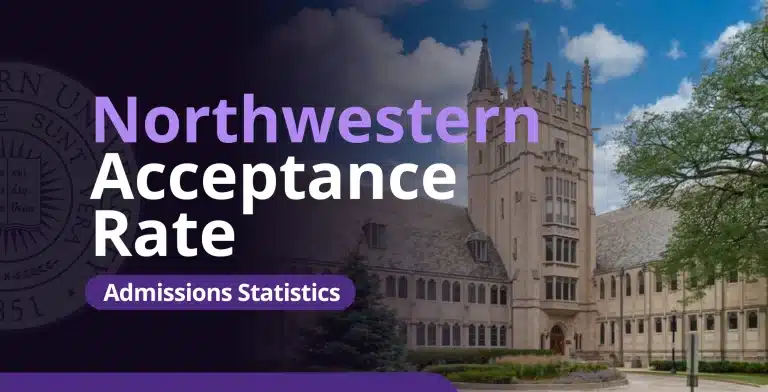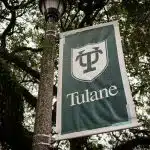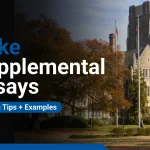Getting into Northwestern University is no easy feat. With its Class of 2029 acceptance rate at a record low of 7%, Northwestern ranks among the most selective schools in the nation. If you’re planning to apply, you’ll need an exceptional application that truly makes you stand out.
In this blog, we’re diving into everything you need to know about Northwestern’s acceptance rate. We’ll break down trends, compare Early Decision and Regular Decision rates, and take a closer look at transfer and waitlist statistics. On top of that, we’ll cover key details like deadlines, GPA expectations, and tips to help your application stand out.
- What Is Northwestern’s Acceptance Rate?
- Northwestern Acceptance Rate Trends
- Northwestern Regular Decision Acceptance Rate
- Northwestern Early Decision Acceptance Rate
- How to Get Accepted into Northwestern
- Northwestern Transfer Acceptance Rate
- Northwestern Waitlist Acceptance Rate
- Frequently Asked Questions
- Takeaways
What Is Northwestern’s Acceptance Rate?
For the Class of 2029, Northwestern announced that it admitted just 7% of over 53,000 applicants, a historic low for the university. This marks a drop from the Class of 2028’s 7.6% admission rate, with the number of applicants increasing from 50,000. This highly selective rate places Northwestern on par with Ivy League schools.
Northwestern has yet to release the exact figures for Early Decision (ED) and Regular Decision (RD), but based on the available recent and historic data, we can estimate the following:
| Application Type | Total Applications (Estimates) | Accepted (Estimates) | Acceptance Rate (Estimates) |
| Regular Decision | 47,000 | 2,510 | 5.3% |
| Early Decision | 6,000 | 1,200 | 20% |
| Overall | 53,000 | 3,710 | 7% |
See the difference? The Early Decision acceptance rate is significantly higher—a trend seen across most elite schools. Applying ED signals strong commitment, and colleges appreciate that. So, if Northwestern is your dream school, applying early could give you an edge.
Northwestern’s acceptance rate tells a clear story: the competition is intense. With applications increasing each year, the acceptance rate continues to shrink. Your application must be polished, personal, and unforgettable to stand out.
Northwestern yield rate
Let’s dive into Northwestern’s yield rate—the percentage of admitted students who actually enroll. For the Class of 2028, 2,105 out of 3,801 admitted students said, “I’m in,” giving Northwestern a yield rate of 55.4%.
To put that into perspective, the national average yield rate for four-year colleges in 2022 was around 30%. Private colleges fared slightly better at 33%, while public colleges hovered near 25%. Northwestern’s yield rate? Miles ahead.
This impressive figure shows that students who get into Northwestern are serious about attending—and for good reason. Northwestern is likely to prioritize applicants who demonstrate genuine interest, increasing the chances that accepted students will actually enroll. So, if Northwestern is on your list, showing your enthusiasm for the school could work in your favor.
Northwestern Acceptance Rate Trends
Northwestern’s acceptance rate has steadily decreased over the past decade, highlighting its rising popularity and increasing competitiveness. Here, we gathered the admissions data from Northwestern’s Common Data Sets:
| Northwestern Class | Total Applications | Overall Acceptance Rate |
| 2029 | 53,000 | 7% |
| 2028 | 50,018 | 7.6% |
| 2027 | 52,233 | 7.2% |
| 2026 | 51,558 | 7.2% |
| 2025 | 47,636 | 7% |
| 2024 | 39,263 | 9.3% |
| 2023 | 40,585 | 9.1% |
| 2022 | 37,259 | 9.2% |
| 2021 | 35,100 | 9.2% |
| 2020 | 32,122 | 13.2% |
For the Class of 2029, Northwestern’s acceptance rate stands at 7%, with over 53,000 applicants competing for a spot. This marks a notable trend of increasing selectivity, as the acceptance rate has steadily dropped from 13.2% for the Class of 2020.
Applications have also surged significantly during this period. For example, the Class of 2023 saw 40,585 applications, a sharp increase compared to earlier years. By the Class of 2026, applications had exceeded 50,000, showcasing Northwestern’s growing popularity.
As application numbers have risen, the acceptance rate has naturally declined, solidifying Northwestern’s reputation as a highly competitive institution.
Several factors help explain Northwestern’s growing competitiveness:
- The Common Application has simplified the process of applying to multiple schools, driving up application numbers across the board.
- As a consistently top-ranked institution, Northwestern attracts interest from students around the globe.
- Test-optional policies introduced during the pandemic broadened the applicant pool, encouraging students who might not have applied otherwise.
Even with these changes, Northwestern’s ability to maintain a low acceptance rate reflects its commitment to selectivity while continuing to appeal to high-achieving applicants.
Northwestern’s acceptance rate vs other Ivy League schools
How does Northwestern stack up against its Ivy League peers? Since Class of 2029 acceptance rates aren’t yet available for all Ivy League schools, let’s compare Northwestern’s 7.6% acceptance rate for the Class of 2028 with those of the Ivies.
|
Ivy League School |
Acceptance Rate (Class of 2028) |
|
3.6% |
|
|
3.7% |
|
|
3.85% |
|
|
4.6% |
|
|
5.2% |
|
|
5.3% |
|
|
5.4% |
|
|
8.4% |
As you can see, Northwestern’s acceptance rate is more competitive than Cornell’s 8.4%, but higher than the rest of the Ivies, which mostly fall between 3.6% and 5.4%. While not an Ivy League member, Northwestern’s selectivity clearly aligns it with the nation’s most elite institutions.
Northwestern has a slightly higher acceptance rate, but don’t be fooled. The competition at Northwestern is just as intense. Its focus on academic rigor and community means only the most impressive applicants make the cut. If Northwestern is your goal, you’ll need a top-notch application to stand out in such a competitive field.
Northwestern Regular Decision Acceptance Rate
The Northwestern acceptance rate for Regular Decision (RD) in the Class of 2029 is around 5.3%. Compared to the Early Decision (ED) acceptance rate of 20% and the overall rate of 7%, it’s clear that RD applicants face an uphill battle.
The difference between RD and ED acceptance rates is significant, highlighting just how competitive the RD round is. ED applicants have a clear edge since they demonstrate a strong commitment to Northwestern as their top choice—something the admissions team often favors. Meanwhile, RD applicants face tougher competition, with fewer available spots and a surge of applications to compete against.
If that wasn’t challenging enough, the trend over the past decade hasn’t made things any easier.
| Northwestern Class | Total Regular Decision Applications | Regular Decision Acceptance Rate |
| 2029 | 47,000 | 5.3% |
| 2028 | 44,811 | 5.9% |
| 2027 | 47,212 | 5.6% |
| 2026 | 47,013 | 5.6% |
| 2025 | 43,225 | 5.2% |
| 2024 | 34,864 | 7.3% |
| 2023 | 36,528 | 7.2% |
| 2022 | 33,429 | 7.2% |
| 2021 | Undisclosed | Undisclosed |
| 2020 | 29,455 | 11% |
Northwestern’s RD acceptance rate has steadily declined, dropping from 11% for the Class of 2020 to just 5.3% today. This downward trend reflects a growing number of applications and Northwestern’s dedication to upholding a highly selective admissions process.
For RD applicants, this means one thing: your application needs to be polished, compelling, and unforgettable. While the RD cycle gives you extra time to refine your materials, the incredibly low acceptance rate means every detail matters.
Northwestern Regular Decision deadline and notification date
If you’re applying RD, here are the key dates to keep in mind. Applications are due by January 2, and decisions are released between late March and early April. If accepted, you’ll have until May 1 to make your final choice.
These deadlines give you some flexibility to put together a standout application and weigh other college offers. But with RD admissions being this competitive, procrastination isn’t an option. Planning ahead can make all the difference in boosting your chances of getting into Northwestern.
Northwestern Early Decision Acceptance Rate
For the Class of 2029, Northwestern’s Early Decision (ED) acceptance rate was around 20%, significantly higher than the overall rate of 7% and the Regular Decision (RD) rate of 5.3%. This stark difference underscores the strategic advantage of applying ED if Northwestern is your top choice.
That said, the ED acceptance rate has gradually declined over the past decade:
| Northwestern Class | Total Early Decision Applications | Early Decision Acceptance Rate |
| 2029 | 6,000 | 20% |
| 2028 | 5,207 | 22.6% |
| 2027 | 5,021 | 22.1% |
| 2026 | 4,545 | 24.3% |
| 2025 | 4,411 | 25.1% |
| 2024 | 4,399 | 24.9% |
| 2023 | 4,057 | 26.6% |
| 2022 | 3,830 | 26.9% |
| 2021 | Undisclosed | Undisclosed |
| 2020 | 2,667 | 37.9% |
For the Class of 2020, Northwestern’s Early Decision acceptance rate was 37.9%, but for the Class of 2029, it had dropped to 20%. This decline reflects both a growing number of ED applications and Northwestern’s increasing selectivity. While applying ED gives you better odds, it’s still far from a guarantee.
Northwestern’s Early Decision policy
Northwestern’s Early Decision policy is binding, meaning if you’re admitted, you’re committing to enroll unless financial constraints make it impossible. An ED acceptance means you’ll withdraw all other college applications and secure your spot at Northwestern.
Why does ED give you an edge? It shows Northwestern that you’re fully committed, which can work in your favor. The admissions team reviews a smaller pool of applicants during ED, allowing them to give more focused attention to your application. Plus, getting an early decision offers peace of mind—if you’re accepted, your college search wraps up before the end of the year.
That said, ED isn’t for everyone. While it can improve your chances, most of Northwestern’s incoming class is admitted during Regular Decision. You should only apply ED if you’re absolutely certain Northwestern is your top choice and are ready to commit if offered admission.
Northwestern Early Decision deadline and notification date
If you’re applying ED, keep these dates in mind: applications are due November 1, decisions are released in mid-December, and you’ll need to confirm your spot by late December.
Planning to go the ED route? Start early. Make sure your application stands out, and take the time to review Northwestern’s financial aid policies if costs are a concern. ED can give you a leg up, but only if you’re ready to commit to making Northwestern your home.
How to Get Accepted into Northwestern
Applying to Northwestern begins with the Common Application. Through the Common App, you can track your progress, ensure everything is submitted on time, and make updates if needed.
Northwestern seeks students who are not only academic standouts but also actively engaged in their communities and eager to make a positive impact. To impress the admissions team, your application should highlight both your intellectual achievements and your personal passions.
Target GPA
While Northwestern doesn’t officially set a minimum GPA, the standards are high. The average GPA for admitted students is 4.1. Moreover, according to Northwestern’s 2023-2024 Common Data Set, nearly 94% of those accepted are ranked in the top 10% of their class. Translation: academic excellence is non-negotiable.
But it’s not just about straight A’s. Admissions officers also value students who push themselves with challenging coursework, such as AP, IB, or honors classes. A strong GPA coupled with rigorous courses demonstrates your readiness for Northwestern’s demanding academics.
If you’re aiming for that 4.1 or higher, you’re on the right track. However, if your GPA isn’t quite there, strong test scores and impressive extracurriculars can help balance things out.
Target test scores
Northwestern remains test-optional for the Class of 2029, meaning you are not required to submit SAT or ACT scores with your application. While there’s no official minimum, here’s the score range for admitted students:
| Standardized Test | 25th Percentile Score | 50th Percentile Score | 75th Percentile Score |
| SAT | 1500 | 1530 | 1560 |
| ACT | 33 | 34 | 35 |
If you want to stay competitive, aim for the 75th percentile—a 1560+ on the SAT or a 35+ on the ACT. High scores can make up for weaker spots in your application and prove you can handle Northwestern’s academic rigor.
Other requirements
Northwestern’s low acceptance rate means every part of your application needs to shine. While strong academics are crucial, it’s your extracurriculars, essays, and recommendations that can truly help you stand out in such a competitive pool.
- Extracurriculars. Northwestern values students who actively engage with the world around them. They’re particularly drawn to leadership, social impact, and sustainability efforts. Activities like volunteering, environmental initiatives, or leading a club can grab their attention. Focus on quality over quantity by sticking to a few meaningful commitments that reflect your passions, rather than spreading yourself too thin.
- Essays. Alongside the Common App personal statement, Northwestern’s application includes three supplemental essays. These prompts are your chance to highlight your personality, values, and how you’d fit into Northwestern’s culture. The topics often focus on creativity, community, and purpose, so use this space to showcase what makes you unique and how you’d contribute to campus life.
- Recommendation letters. Northwestern requires three recommendation letters—two from teachers and one from your counselor. Choose teachers who know you well and can speak to your academic abilities and work ethic. Additionally, Northwestern allows an optional fourth letter from a peer. This is a great opportunity to show how you’re perceived by someone who knows you on a personal level.
Finding balance and presenting your full self is key. If you’re ready to go all in, check out our comprehensive guide for more tips on crafting a standout Northwestern application.
Northwestern Transfer Acceptance Rate
If you think getting into Northwestern as a first-year student is challenging, transfer admissions take it to an entirely new level.
According to the 2023-2024 Common Data Set, the Northwestern acceptance rate for transfer applicants is just 12.7%. Out of 3,507 hopefuls, only 447 were admitted and just 237 decided to enroll. The numbers make it clear: transfer spots are extremely limited, and the competition is fierce.
Here are a few things to remember:
- Transfer admissions at Northwestern place more emphasis on your college performance than your high school record. To stand out, you’ll need a strong academic track record at your current institution, preferably one that’s already highly selective.
- Admissions officers are also looking for thoughtful, well-crafted essays that clearly explain why you want to transfer. You need to articulate how its specific programs, opportunities, or culture align with your long-term goals. Use this space to share your academic journey, why your current school isn’t meeting your needs, and why Northwestern is the ideal place for you to succeed.
- Beyond academics, Northwestern values traits like community engagement and intellectual curiosity. With transfer spots being so limited, it’s crucial to show not only why Northwestern is the perfect fit for you but also how you’ll contribute to their vibrant community.
Given the highly competitive nature of Northwestern’s transfer admissions, preparation is key. Start early, research the school thoroughly, and make your case as compelling as possible. While transferring to Northwestern is no easy feat, a well-prepared application can help you make the most of your opportunity.
Northwestern Waitlist Acceptance Rate
Northwestern’s waitlist can feel like a gamble, and the stats back that up. According to the 2023-2024 Common Data Set, only 55 waitlisted students were admitted.
Northwestern doesn’t publish its waitlist acceptance rate, but recent numbers shed some light on the process. For the Class of 2027, 83 waitlisted students were admitted, while only 69 were accepted for the Class of 2026.
In some years, however, no one makes it off the waitlist. This variability comes down to enrollment numbers—if more admitted students accept their offers than anticipated, there’s no space left for waitlist candidates.
What to do if you’re waitlisted
Being waitlisted at Northwestern isn’t a rejection. It’s more like a “maybe if circumstances change.” The admissions team recognizes your potential but currently doesn’t have space in the class. Your application will only be reconsidered if enough spots open up because other students decline their offers.
Here’s how you can make the most of the situation:
- Accept your spot. If you’re still interested in Northwestern, follow the instructions to confirm your place on the waitlist. This keeps you in the running.
- Send a Letter of Continued Interest (LOCI). Use this opportunity to let Northwestern know you’re still committed. Highlight any new achievements, awards, or improved grades since your application. Keep it concise but impactful to reinforce your enthusiasm.
- Plan for other options. Make sure to commit to another school by the May 1 deadline. This ensures you have a solid backup plan while waiting on Northwestern.
- Prepare for a long wait. Waitlist decisions often stretch into the summer, so be ready to stay patient and flexible as you navigate your next steps.
Being on Northwestern’s waitlist can be stressful, but it’s not the end of your journey. Stay proactive, keep your options open, and remember that much of the process is beyond your control. Whether Northwestern works out or not, you’ll find a place where you can thrive and succeed.
Frequently Asked Questions
1. What is Northwestern’s latest overall acceptance rate?
Northwestern’s latest overall acceptance rate for the Class of 2029 is 7%. Out of over 53,000 applicants, just around 3,710 were admitted.
2. What is Northwestern’s Early Decision acceptance rate?
For the Class of 2029, Northwestern’s Early Decision acceptance rate was 20%, much higher than its overall and Regular Decision rates. It’s a clear reminder that applying early gives you a noticeable edge (if Northwestern is your first choice, that is).
3. What is Northwestern’s Regular Decision acceptance rate?
When it comes to Regular Decision, the Northwestern acceptance rate for the Class of 2029 drops to 5.3%. With around 47,000 RD applications, only about 2,510 students got a slot.
4. What is Northwestern’s transfer acceptance rate?
According to Northwestern’s 2023-2024 Common Data Set, the transfer acceptance rate is just 12.7%. Out of 3,507 hopefuls, only 447 were admitted. It’s a tiny pool of available spots, which makes transferring to Northwestern one of the most competitive processes out there.
5. What is Northwestern’s waitlist acceptance rate?
Northwestern doesn’t publish its waitlist acceptance rate, but its recent numbers do shed some light on the process. For the Class of 2027, 55 students were admitted from the waitlist. However, there have been instances wherein no one makes it off the waitlist.
Takeaways
If you’re eyeing Northwestern, understanding the acceptance rate is a big deal. Here are five main takeaways to keep in mind:
- The Northwestern acceptance rate for the Class of 2029 is 7%. Out of over 53,000 applicants, only around 3,710 were admitted.
- Compared to Ivies, Northwestern’s selectivity is somewhere in the lower middle.
- With a 20% acceptance rate for ED applicants, it’s clear Northwestern values commitment. That’s a big jump from the 5.3% RD acceptance rate. If Northwestern is your dream school, applying early might give you a leg up.
- To stay competitive, aim for a GPA of 4.1 or higher, an SAT score of around 1560+, or an ACT score of 35+. Standout essays, meaningful extracurriculars, and solid recommendation letters are equally important.
- Given how low the Northwestern acceptance rate is, consider getting professional guidance. A college admissions consultant can help you fine-tune your application and boost your chances of getting into Northwestern.

Eric Eng
About the author
Eric Eng, the Founder and CEO of AdmissionSight, graduated with a BA from Princeton University and has one of the highest track records in the industry of placing students into Ivy League schools and top 10 universities. He has been featured on the US News & World Report for his insights on college admissions.










